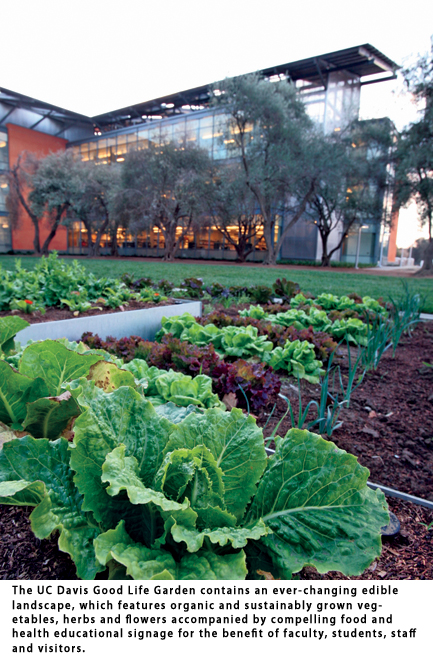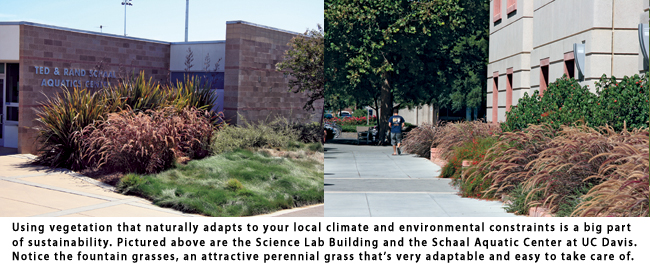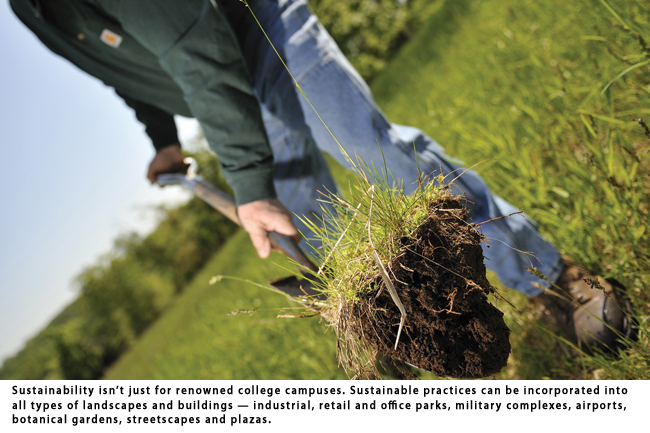The Campus Green

Sustainability is the capacity to endure.
For ecosystems, that means cultivating a diverse and productive habit that survives for centuries or a millennium. For humans, it means living mutually with our environment — ecologically, socially and economically. At schools like the University of California Davis (UC Davis), sustainability practices have become a culture, where it’s as much about implementation as it is about education.
“In California, sustainability practices have been around for a while,” says Cary Avery, CGM landscape superintendent with UC Davis. “Here, it comes from an education that started with our students — probably in grammar school, junior high and in high school. By the time they get to the university, our students understand sustainability. They call us all the time wanting to know why we’re doing this or why we’re doing that.”
Avery has been working at UC Davis for 25 years, 10 of those years as the landscape superintendent, overseeing a staff of foremen and laborers, managing landscapes, cutting lawns and planting flowers, doing payroll and bidding jobs and spearheading everything it takes to maintain a campus at one of the nation’s top public research universities (U.S. News and World Report ranked UC Davis as the ninth best public university in the United States in 2010). The school is located in the heart of the Central Valley, spanning 5,500 acres across two counties, close to the state capital and the San Francisco Bay area.
UC Davis’s landscape is considered an oasis in a desert. The annual rainfall is 12 to 16 in., and most rain falls from December to March. Soils range from sandy to heavy clay. Irrigation water is from shallow wells (100 ft); drinking water is from 300-ft wells. The irrigated water has a high mineral content with high levels of boron, and temperatures can drop into the teens in winter and can be over 100 F for 30 or more days in the summer. To say the least, the campus at UC Davis is a diversity of challenges when it comes to living sustainably with the local environment.
“When we first started this, I would scratch my head and think, ‘How are we going to do this?’’’ laughs Avery. “Over time we learned. We also learned it can be very practical. Through trial and error, we found out what works and what really doesn’t. And now we have laws here in California where we have to control runoff and storm water, so some of these things have become very practical for us. Otherwise, we’re going to be fined. Laws are coming into place now — where if you’re not ready for it — your grounds operation is going to have a problem.”
It’s not just universities. It’s industrial, retail and office parks, military complexes, airports, botanical gardens, streetscapes and plazas, residential and commercial developments and public and private campuses. All types of grounds and building categories are being forced to consider the values of added efficiency, greener practices, state laws and LEED certifications, a national rating system that is used to distinguish the sustainability of one building when compared to another. The future is sustainable landscaping and building, and now is the time to start planning for the future.
Putting Ideas into Practice
For grounds managers, landscapers and construction architects, there are many places to begin your sustainability journey — places like the Professional Grounds Management Society (PGMS), Professional Landscape Society (PLANET) and the Sustainable Sites Initiative (SITES). Through the organizations mentioned, managers, crews and construction professionals can learn how to improve their corners of the planet with a plan and best practices portfolio.
Sustainability operations require practices to create greener and efficient ideas in land development, addressing increasingly urgent global concerns such as climate change, loss of biodiversity and resource depletion. These design tools can be used by those who construct, operate and maintain landscapes, including but not limited to planners, landscape architects, engineers, developers, builders, maintenance crews, horticulturists, governments, land stewards and organizations offering building standards. Breaking it down into bullet points, here is a basic framework of popular sustainable practices for the landscape or building professional:
- Regulate global and local climate
- Detoxify and cleanse air, soil and water
- Regulate water supply
- Control erosion and retain sediment
- Provide refuge, nursery habitat and pollination services
- Decompose, treat and re-use waste
- Provide human health and well-being benefits
- Provide food and non-food products
- Provide cultural, educational and aesthetic values
“A good place to start is through associations like PGMS, and looking at their sustainability practices and some of the things they’re suggesting,” explains Avery. “I’ll be very honest. We found out in the early going that some things sound good, but they’re not practical and they’re expensive. For instance, the hot thing for the first few years, was planting grasses. Grasses are great, but not very practical, depending on the region and where you’re putting them. On a campus, they introduce a lot of problems, such as rats and rodents — because we have a food base — students who leave other food around all the time. So it’s trial and error.”
It’s taken years for UC Davis to develop its sustainable operations. Even with a staff of 85 grounds professionals, Avery relies on the help of students and university management to create a culture of sustainability. Take campus transportation for instance (students, faculty and grounds staff). Forty percent ride bikes, 29 percent use cars, 13 percent ride the bus and 18 percent walk. Most of the staff drives electric or hybrid vehicles or they bike to work. It’s about getting everyone involved. It’s also about strict practices. Avery goes on to name the top 10 sustainable initiatives at UC Davis.
- Storm Water Retention — All new projects must address keeping water onsite.
- Landscape Irrigation Practices — This includes RainMaster Controllers, which are connected to weather stations, no-drip and low GPM spray systems and use of recycled water in limited areas of campus.
- Choice of Plant Materials — This means less lawn (only where needed for activity), eliminating small lawns in older landscapes, Cast Iron plants (proven plants that grow well in the area), low water use, heat tolerant vegetation, cold tolerant plants, trees (use of more Oaks), strict existing Plant Protection Guidelines for new construction and use of structural soil in paved areas for trees.
- Green Waste Recycling — All trimmings are chipped and reused as mulch in the campus landscape, which helps with soil erosion and plant nutrition.
- Recycle Materials — Used when purchasing products, reusing surplus materials that are already on campus such as redwood and pavers.
- Shading — This includes the shading of all parking lots (50 percent) and roads and paths (100 percent) with trees.
- Edible Landscape — On campus, staff and students maintain and harvest olives from the campus landscape for UDC Olive Oil. There are also small plots of vegetable gardens at certain buildings. Just check out the campus Good Life Garden on the web at www.goodlifegarden.ucdavis.edu, its use of fruit trees on campus and the community gardens at Student Housing projects.
- Permeable Pavings — Use interlocking pavers in many new landscapes, as well as permeable concrete and recycled paving for rural roads (concrete and asphalt).
- Site Design — Consider solar orientation for new buildings and solar control with trees and shrubs (deciduous on south sides of buildings and evergreen on north sides of buildings).
- Fertilizers and Pesticides — The university currently uses mostly organic fertilizers and very limited pesticides.
Schools of Sustainability
Someone once said modern technology owes ecology an apology. With smart sustainability operations, a modern grounds manager can start to give something back to our natural habits. The associations mentioned here are a great place to start the education process; Avery is on the Sustainability Committee for PGMS, which reviews industry standards and makes suggestions. But one of the best resources is the Sustainable Sites Initiative (SITES), which is an interdisciplinary effort by the American Society of Landscape Architects, the Lady Bird Johnson Wildflower Center at the University of Texas at Austin and the United States Botanic Garden. They’ve created voluntary national guidelines and performance benchmarks for sustainable land design, construction and maintenance practices.
“The Sustainable Sites Initiative and its website [www.sustainablesites.org] have very clear standards for what you can aspire to,” says Avery.
The central message of SITES is that any landscape — whether the site of a university campus, large subdivision, shopping mall, park, abandoned rail yard or even one home — holds the potential both to improve and to regenerate the natural benefits and services provided by ecosystems in their undeveloped state. While standards exist for sustainable structures — “green buildings” — there are no comprehensive guidelines and performance benchmarks for those who want to create and measure sustainable landscapes. Yet, landscapes have great potential for both environmental good and severe environmental damage.
Just think of an element like greenhouse gas emissions. Vegetation and soil help reduce the amount of carbon dioxide, a greenhouse gas, in the atmosphere by capturing and storing it for use in producing roots, leaves and bark. In the United States, urban trees capture up to 25 million tons of carbon each year. Could your corner of the world reduce a little more? It’s up to the values and knowledge of each grounds operation to explore and implement some of these ideas. It will take some trial and error, and it might be a little more expensive at first, but it’s definitely the future of landscaping.
“Grounds managers used to laugh at me. I’d say, ‘Hey, stop laughing. It’s going to be in your area before you know it,’” says Avery. “People really have to buy into it. In the end, it is cheaper, but in the beginning, for the first couple of years, it is a little more expensive. In some ways, you’re going to, and this might not be good for your magazine, have less mechanization and more hands-on labor. To summarize the whole sustainability thing up: It’s planting less turf and using more sustainable plants or more water tolerant plants. And it’s here to stay.”
Keith Gribbins is managing editor of Compact Equipment, based in Peninsula, Ohio.




Comments are closed here.